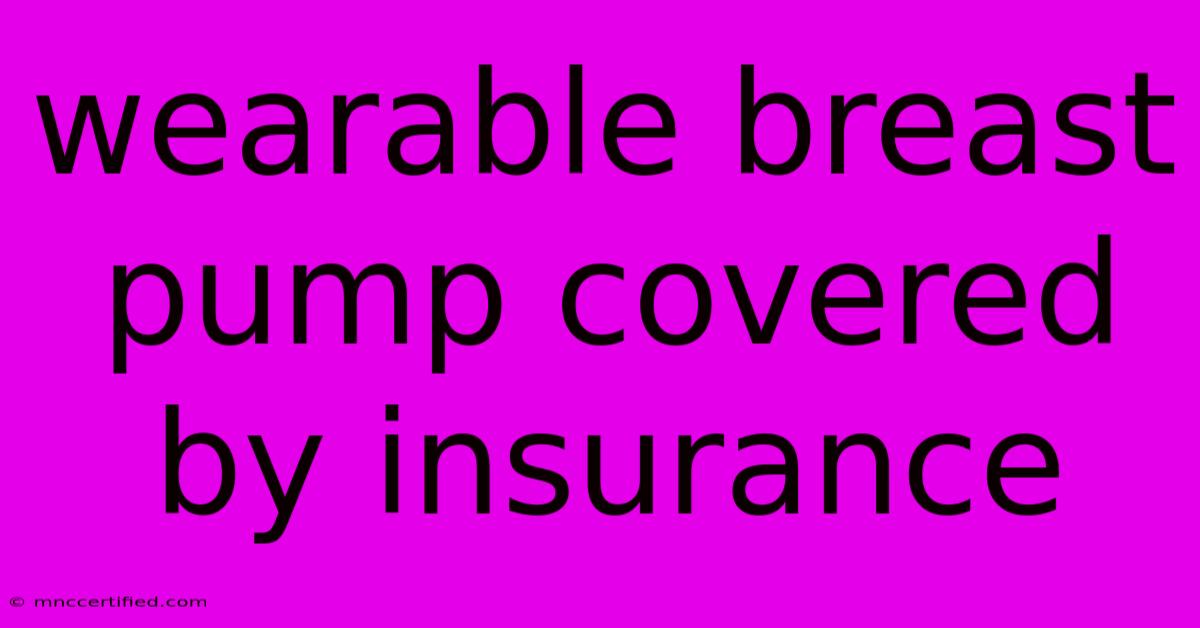Wearable Breast Pump Covered By Insurance

Table of Contents
Is Your Wearable Breast Pump Covered by Insurance? A Comprehensive Guide
Congratulations on your journey into motherhood! As you prepare for the arrival of your little one, you're likely researching various options for breastfeeding, including breast pumps. Wearable breast pumps are becoming increasingly popular, offering discreet and convenient pumping experiences. But one question that often arises is: will insurance cover my wearable breast pump?
This comprehensive guide will answer that question and provide you with all the information you need to navigate the world of insurance coverage for wearable breast pumps.
Understanding Insurance Coverage for Breast Pumps
The Affordable Care Act (ACA) requires most health insurance plans to cover breast pumps and related supplies. However, there are specific regulations and requirements that vary depending on your insurance provider.
Here's what you need to know:
- Most plans cover breast pumps, but the type may vary: Your insurance plan may cover a manual, electric, or hospital-grade breast pump.
- Coverage is often limited to one pump per pregnancy: This means you might not be able to get a second pump even if you have twins or if your first pump malfunctions.
- Pre-authorization may be required: Check with your insurance company about their specific pre-authorization process.
- Coverage may not include all accessories: While the pump itself is usually covered, additional accessories like pump bags, bottles, and storage bags might not be.
- Specific brands may be preferred: Some insurance plans have a preferred list of breast pump manufacturers.
Wearable Breast Pumps and Insurance Coverage
Wearable breast pumps are a relatively new technology, and insurance coverage for them can be tricky. Here's what you should know:
- Not all insurance plans cover wearable breast pumps: While some insurance providers are starting to include them in their coverage, others might not.
- Consider using an HSA or FSA: If your insurance doesn't cover a wearable pump, you might be able to use your Health Savings Account (HSA) or Flexible Spending Account (FSA) funds to purchase one.
- Check your plan's specific language: Carefully review your insurance policy to see if wearable breast pumps are mentioned or if there are any specific exceptions.
- Contact your insurance provider directly: The best way to confirm coverage is to call your insurance company and ask directly. Be prepared to provide your plan details and the specific model of wearable pump you're considering.
What To Do If Your Insurance Doesn't Cover a Wearable Pump
If your insurance plan doesn't cover a wearable breast pump, don't despair! There are still ways to get one:
- Consider a traditional breast pump: A traditional electric or manual breast pump can be a great alternative and is often covered by insurance.
- Explore financing options: Some retailers offer financing plans that can help you make payments over time.
- Reach out to lactation consultants: Lactation consultants can provide valuable guidance and connect you with resources for affordable breast pumps.
Tips for Navigating Insurance Coverage
- Start early: Don't wait until the last minute to start researching insurance coverage. Begin your research during your first trimester.
- Gather all your insurance information: Have your insurance policy, member ID number, and plan details handy.
- Keep detailed records: Document all your interactions with your insurance provider, including dates, times, and any documentation you receive.
- Don't be afraid to ask for clarification: If you're confused about any aspect of insurance coverage, don't hesitate to ask for clarification.
Remember: Your insurance company is there to help you. By understanding your policy and asking the right questions, you can ensure you have access to the best breast pump for your needs.

Thank you for visiting our website wich cover about Wearable Breast Pump Covered By Insurance. We hope the information provided has been useful to you. Feel free to contact us if you have any questions or need further assistance. See you next time and dont miss to bookmark.
Featured Posts
-
What To Do If Insurance Denied Roof Claim
Nov 07, 2024
-
Ivanka Trump At Trumps Election Party
Nov 07, 2024
-
Californias Crime Shift Downtowns And Public Safety
Nov 07, 2024
-
Independent Insurance Agents In Madison Wi
Nov 07, 2024
-
Musiala We Had To Win After Benfica Victory
Nov 07, 2024